RBSE Class 12 Physics Important Questions Chapter 8 Electromagnetic Waves
Rajasthan Board RBSE Class 12 Physics Important Questions Chapter 8 Electromagnetic Waves Important Questions and Answers.
Rajasthan Board RBSE Solutions for Class 12 Physics in Hindi Medium & English Medium are part of RBSE Solutions for Class 12. Students can also read RBSE Class 12 Physics Important Questions for exam preparation. Students can also go through RBSE Class 12 Physics Notes to understand and remember the concepts easily. Browsing through wave optics important questions that include all questions presented in the textbook.
RBSE Class 12 Physics Chapter 8 Important Questions Electromagnetic Waves
Multiple Choice Questions
Question 1.
The concept of displacement current was introduced by:
(A) Maxwell
(B) Hertz
(C) Ampere
(D) Marconi.
Answer:
(A) Maxwell

Question 2.
An accelerated electron will produce:
(A) Electromagnetic waves
(B) α-rays
(C) ß-rays
(D) γ-rays.
Answer:
(A) Electromagnetic waves
Question 3.
Which is the longest wavelength?
(A) Radio waves
(B) X-rays
(C) U.V. rays
(D) I.R. rays.
Answer:
(A) Radio waves
Question 4.
Which of the following radiations has highest frequency?
(A) γ-rays
(B) X-rays
(C) ß-rays
(D) ultra-violet rays
Answer:
(A) γ-rays
Question 5.
The amplitude of electric and magnetic fields related to each other are:
(A) E0 = \(\frac{\mathrm{B}_0}{c}\)
(B) E0 = cB0
(C) E0 = B0
(D) E0 = \(\frac{c}{\mathrm{~B}_0}\).
Answer:
(B) E0 = cB0

Question 6.
Radio waves of constant amplitude can be generated with:
(A) rectifier
(B) filter
(C) F.E.T.
(D) Oscillator.
Answer:
(D) Oscillator.
Question 7.
Which rays are not the portion of electromagnetic spectrum?
(A) X-rays
(B) micro waves
(C) α-rays
(D) radio waves.
Answer:
(C) α-rays
Question 8.
Which of the following represents an infrared wavelength?
(A) 10-4 cm
(B) 10-5 cm
(C) 10-6 cm
(D) 10-7 cm.
Answer:
(A) 10-4 cm
Question 9.
Write an expression for speed of e.m. waves in free space.
(A) c = \(\frac{1}{\sqrt{\mu_0 \varepsilon_0}}\)
(B) c = \(\frac{\mathrm{E}_0 \mathrm{~N}_0}{\mathrm{~B}_0}\)
(C) c = \(\frac{\mathrm{E} \varepsilon_0}{\mathrm{~B}}\)
(D) All of these.
Answer:
(A) c = \(\frac{1}{\sqrt{\mu_0 \varepsilon_0}}\)
Question 10.
Electromagnetic waves are produced by:
(A) static charge
(B) chargeless particles
(C) Accelerating charge
(D) None of these.
Answer:
(C) Accelerating charge
Question 11.
Frequency of visible light is of the order of:
(A) 108 Hz
(B) 1010 Hz
(C) 1012 Hz
(D) 1015 Hz.
Answer:
(D) 1015 Hz.

Question 12.
Which of the following e.m. waves has the highest wavelength?
(A) X-rays
(B) Microwaves
(C) Infra-red waves
(D) Ultra-violet rays.
Answer:
(B) Microwaves
Question 13.
The speed of electromagnetic waves is independent of:
(A) wavelength
(B) frequency
(C) intensity
(D) medium in which it travels.
Answer:
(C) intensity
Question 14.
Electromagnetic waves are produced by:
(A) static charge
(B) chargeless particles
(C) accelerating charge
(D) None of these.
Answer:
(C) accelerating charge
Question 15.
When light travels from air to water, which parameter does not change?
(A) wavelength
(B) frequency
(C) velocity
(D) All of these.
Answer:
(B) frequency
Question 16.
The value of velocity of light in vacuum is:
(A) \(\sqrt{\frac{\mu_o}{\varepsilon_0}}\)
(B) \(\frac{1}{\sqrt{\mu_0 \varepsilon_0}}\)
(C) \(\sqrt{\mu_{\mathrm{o}} \varepsilon_{\mathrm{o}}}\)
(D) \(\sqrt{\frac{\varepsilon_{\mathrm{o}}}{\mu_{\mathrm{o}}}}\)
Answer:
(B) \(\frac{1}{\sqrt{\mu_0 \varepsilon_0}}\)
Question 17.
Which of the following has minimum wavelength:
(A) X-rays
(B) Ultraviolet rays
(C) γ-rays
(D) None of these.
Answer:
(C) γ-rays
Question 18.
According to Maxwell’s hypothesis, a changing electric field gives rise to:
(A) an emf
(B) electric current
(C) magnetic field
(D) pressure gradient.
Answer:
(C) magnetic field
Question 19.
Dimensions of \(\frac{1}{\mu_0 \varepsilon_0}\), where symbols have their usual meanings are:
(A) [L-1T]
(B) [L-2T2]
(C) [L2T-2]
(D) [LT-1].
Answer:
(C) [L2T-2]

Question 20.
The velocity of electromagnetic wave is parallel to:
(A) \(\overrightarrow{\mathrm{B}} \times \overrightarrow{\mathrm{E}}\)
(B) \(\overrightarrow{\mathrm{E}} \times \overrightarrow{\mathrm{B}}\)
(C) \(\overrightarrow{\mathrm{E}}\)
(D) \(\overrightarrow{\mathrm{B}}\)
Answer:
(B) \(\overrightarrow{\mathrm{E}} \times \overrightarrow{\mathrm{B}}\)
Question 21.
The correct arrangement of colours in the descending order of wavelength is:
(A) yellow, violet, green, orange
(B) orange, yellow, green, violet
(C) violet, green, yellow, orange
(D) yellow, green, orange, violet.
Answer:
(B) orange, yellow, green, violet
Question 22.
The dimensions of E/B (Electric field/Magnetic field) are the same as that of:
(A) Acceleration
(B) Velocity
(C) Charge
(D) Current.
Answer:
(B) Velocity
Question 23.
The nature of electromagnetic wave is:
(A) Transverse
(B) Longitudinal
(C) Horizontal
(D) Vertical.
Answer:
(A) Transverse
Question 24.
The electromagnetic waves used in the telecommunication are:
(A) Ultra-violet waves
(B) Microwaves
(C) Visible rays
(D) Infrared rays.
Answer:
(B) Microwaves
Question 25.
The penetrating power is maximum for:
(A) α-rays
(B) ß-rays
(C) γ-rays
(D) None of these.
Answer:
(C) γ-rays
Fill in the blanks
Question 1.
Electromagnetic waves are .................................... in nature.
Answer:
transverse.
Question 2.
.................................... was the first scientist who produced e.m. waves in laboratory.
Answer:
H. Hertz.

Question 3.
.................................... vector is responsible for optical effect.
Answer:
Electric.
Question 4.
When e.m. waves strike a surface, they exert .................................... on it.
Answer:
pressure.
Question 5.
The .................................... current is always equal to the conduction current.
Answer:
displacement.
Question 6.
In material medium, velocity of e.m. wave is ....................................
Answer:
c = \(\frac{1}{\sqrt{\mu \varepsilon}}\)
Question 7.
Displacement current .................................... produce magnetic field.
Answer:
can.
Question 8.
U.V. radiations are used for .................................... preservation.
Answer:
Food.

Question 9.
All electromagnetic waves in vacuum have the .................................... velocity.
Answer:
same.
Question 10.
Ozone layer lies at a height of about .................................... to .................................... from the surface of earth.
Answer:
30 km, 50 km.
Very Short Answer Type Questions
Question 1.
State Ampere's law and Faraday's law in mathematical form.
Answer:
(i) \(\oint \overrightarrow{\mathrm{B}} \cdot \overrightarrow{d l}=\mu_0 \varepsilon_0 \frac{d \phi_{\mathrm{E}}}{d t}\)
(ii) \(\oint \overrightarrow{\mathrm{E}} \cdot \overrightarrow{d l}=-\frac{d \phi_{\mathrm{B}}}{d t}\)
Question 2.
What is Maxwell's modification of Ampere's circuital law?
Answer:
Ampere's circuital law is given by
\(\oint_{\mathrm{C}} \overrightarrow{\mathrm{B}} \cdot \overrightarrow{d l}=\mu_0 \mathrm{I} \)where I is the current across a surface whose periphery is the loop C.
The equation was modified by Maxwell as follows:
\(\oint \overrightarrow{\mathrm{B}} \cdot \overrightarrow{d l}=\mu_0 \mathrm{I}+\mu_0 \varepsilon_0 \frac{d \phi_e}{d t}\)
where Φe is the electric flux across the loop.
Question 3.
What is approximate range of wavelength absorbed by ozone layer?
Answer:
All sun radiations of wavelength λ < 3 x 107 m are absorbed by the ozone layer.
Question 4.
What is displacement current?
Answer:
Displacement current is that current which comes into existence in addition to conduction current when the electric field and hence the electrical flux is changing with time.
Displacement current is a source of magnetic field.

Question 5.
Name the electromagnetic radiations used for (a) Water purification, and (b) eye surgery.
Answer:
(a) For water purification ultra-violet rays are used.
(b) For eye surgery, infrared rays are used.
Question 6.
What is the use of ozone layer?
Answer:
The ozone layer present at a distance of 50 km above the surface of the earth blocks the passage of UV radiations coming from the sun. In this way, it effectively protects us from the harmful portions of solar radiation.
Question 7.
“Ozone layer acts as a protective blanket for earth's life.” Comment in one line.
Or
The small ozone layer on the top of the stratosphere is crucial for human survival. Why?
Answer:
Ozone acts as a shield and does not allow ultraviolet rays (which are harmful to human being) to pass through it.
Question 8.
Arrange the following radiations in descending order of wavelength:
γ-rays, infrared rays, red light, yellow light, radiowaves.
Answer:
Radiowaves, infrared rays, red light, yellow light and γ-rays.
Question 9.
What is electromagnetic spectrum?
Answer:
An orderly distribution of electromagnetic radiations in increasing or decreasing order of wavelength or frequency is called electromagnetic spectrum.
Question 10.
What are microwaves? Give their any one use.
Answer:
Microwaves are radio waves of frequency range 3 x 1011 Hz to 108 Hz. These are used in Radar, T.V. and communication.
Question 11.
Is it necessary to use satellite for long distance TV transmission? Why?
Answer:
Yes, because for long distance TV transmission, the TV signals are not reflected back to earth.
Question 12.
Why can light travel in vacuum whereas sound cannot?
Answer:
Light consists of e.m. waves which do not require any material medium to travel so light can travel in vacuum. Sound consists of material waves which require material medium to travel. So sound waves cannot travel in vacuum.
Question 13.
Explain the term (i) ground waves and (ii) sky waves.
Answer:
(i) Ground waves are waves which are directly received from the transmitter.
(ii) Sky waves are waves which are received after reflection from the ionosphere.
Question 14.
Why is transmission of signals using ground waves are restricted only to a frequency of 1500 kHz.
Answer:
Because above a frequency of 1500 kHz, the absorption of signals from earth's surface increases.
Question 15.
Which part of electromagnetic spectrum has the largest penetration power?
Answer:
Most energetic has to be most powerful. Since E = hv, where v is the frequency of radiation. The γ-rays have maximum frequency among all radiation and hence has maximum energy and penetration power.

Question 16.
Write an expression for speed of e.m. waves in free space.
Answer:
Speed of e.m. waves,
c = \(\frac{1}{\sqrt{\mu_0 \varepsilon_0}}=\frac{\mathrm{E}_0}{\mathrm{~B}_0}\).
Question 17.
State two properties of electro-magnetic waves.
Answer:
- Velocity of the electromagnetic waves in free space is 3 x 108 ms-1.
- They are transverse in nature.
Question 18.
What are electromagnetic waves?
Answer:
Electromagnetic waves are those in which there are sinusoidal variation of electric and magnetic fields at right angles to the direction of the wave.
Question 19.
How does the relation c = \(\frac{1}{\sqrt{\mu_0 \varepsilon_0}}\) indicate that the velocity of all types of e.m. waves in free space is the same?
Answer:
The velocity of any type of electromagnetic wave is given by
c = \(\frac{1}{\sqrt{\mu_0 \varepsilon_0}}\)
Here constants µ0 and ε0 are independent of the frequency.
Question 20.
What is a plane polarised e.m. wave?
Answer:
A plane polarised e.m. wave is that wave in which the electric or magnetic vector oscillates only in one plane to the direction of propagation.
Question 21.
Identify the part of the electromagnetic spectrum to which the following wavelengths belong
(i) 1 mm (ii) 10-11 m
Answer:
(i) Microwaves/short waves
(ii) gamma rays/ X-rays
Question 22.
What is the ratio of speeds of γ-rays and radio waves in vacuum?
Answer:

Question 23.
Name the part of the electromagnetic spectrum of wavelength 10-2 m and mention its one application.
Answer:
Electromagnetic waves of wavelength 10-2 m belongs to microwaves. It is used in RADAR.

Question 24.
Name the part of electromagnetic spectrum of wavelength 102 m and mention its one application.
Answer:
Wavelength 102 m belongs to radio-waves. Radio wave are used to transmit radio and TV signals.
Question 25.
Name the scientist, who first:
(i) Predicted the existence of electromagnetic waves.
(ii) Experimentally demonstrated the existence of electromagnetic waves.
Answer:
(i) James Clark Maxwell
(ii) H. Hertz.
Question 26.
Arrange the given electromagnetic radiations in the descending order of their frequencies. Infrared, X-rays, ultraviolet and gamma rays.
Answer:
Gamma rays, X-rays, Ultraviolet and infrared.
Question 27.
Name the electromagnetic spectrum which is used for taking photographs of earth under foggy conditions from great heights.
Answer:
Infrared radiations.
Question 28.
Name the electromagnetic waves that have frequencies greater than those of ultraviolet light but less than those of gamma rays.
Answer:
X-rays.
Question 29.
Name the electromagnetic radiations used for studying the crystal structure of solids.
Answer:
X-rays.
Question 30.
Why are microwaves used in RADAR?
Answer:
Because microwaves are of short wavelength and they go straight in a specified direction without bending, hence they are used in RADAR.
Question 31.
Which part of electromagnetic spectrum is used in operating a RADAR?
Answer:
Microwaves.
Question 32.
Give a reason to show that microwaves are better carriers of signals for long range transmission than radio waves.
Answer:
Microwaves are of short wavelength and hence they can go straight from the transmitter in a specified direction without bending.
Question 33.
Which out of the following are electromagnetic waves: X-rays, sound waves and radiowaves?
Answer:
X-rays and radiowaves are electromagnetic waves.
Question 34.
Is the ratio of frequencies of ultraviolet rays and infrared rays in glass more than, less than or equal to 1?
Answer:
\(\frac{v_{u, v .}}{v_{\mathrm{I} . r}}>1\).
Question 35.
What is the ratio of speed of infrared rays and ultraviolet rays in vacuum?
Answer:
\(\frac{c_{i r}}{c_{u v}}\) = 1

Question 36.
A plane electromagnetic wave travels in vacuum along z-direction. What can you say about the direction of electric and magnetic field vectors.
Answer:
When electromagnetic wave is travelling along z-direction, the electric and magnetic field vectors are x - y plane. Thus all three are mutually perpendicular to each other.
Question 37.
What is the range of frequencies used for T.V. transmission?
Answer:
≈ 50 MHz to 550 MHz.
Question 38.
Name the characteristics of electro-magnetic waves that (i) Increases (ii) remains constant in the electromagnetic spectrum as one moves from radio wave towards ultraviolet region.
Answer:
(i) Frequency
(ii) Speed in free space.
Question 39.
From the following, identify the electromagnetic waves having the (i) maximum (ii) minimum frequency.'
(i) Radio waves
(ii) Gamma rays
(iii) Visible light
(iv) Microwaves
(v) Ultraviolet rays and
(vi) Infrared rays.
Answer:
Maximum: Gamma rays
Minimum: Radio waves.
Question 40.
State the condition under which a microwave oven heats up a food item containing water molecules most efficiently.
Answer:
The frequency of microwaves should match the resonant frequency of the water molecules in the food.
Question 41.
How is the speed of em waves in vacuum determined by the electric and magnetic field?
Answer:
In vacuum, the speed of em wave is the ratio of peak value of electric field and magnetic field.
i.e. c = \(\frac{E_0}{B_0}\).
Question 42.
Name the part of electromagnetic spectrum, which is used in greenhouse to keep the plants warm.
Answer:
Infrared rays.
Question 43.
Which part of electromagnetic spectrum has the largest penetrating power?
Answer:
Gamma Rays. They can pepetrate through several centimetres thick iron and lead blocks.
Question 44.
Arrange the following electromagnetic radiation in ascending order of their frequencies.
(i) Microwaves
(ii) Radiowaves
(iii) X-rays
(iv) Gamma Rays.
Answer:
Gamma rays, X-rays, microwaves and radiowaves.
Question 45.
In what ways the directions of the electric and magnetic field vectors representing an electromagnetic wave related to each other?
Answer:
The direction of electric and magnetic field vectors in an electromagnetic wave are perpendicular to each other and both are perpendicular to the direction of propagation of the wave.
Short Answer Type Questions
Question 1.
(a) Why are Infrared waves often called heat waves? Explain.
(b) What do you understand by the statement, electromagnetic waves transport momentum?
Answer:
(a) Infrared rays can vibrate the whole molecule of a body on which it falls and after absorption, their thermal motion increases and hence temperature of the body increases. So infrared rays are called heat waves.
(b) Electromagnetic waves contains electric and magnetic field. When these waves strike a surface, a pressure is exerted on the surface, it shows that momentum is carried by electromagnetic waves. The movementum is given by p = \(\frac{E}{C}\).
Question 2.
Describe importance of displacement current.
Answer:
Conduction current exists in region above plate A due to incoming positive charges. It also exists below plate B due to outgoing positive charges. Displacement current exists between plates A and B.
This gives continuity to the path through the capacitor (during its charging).
Question 3.
Give difference between displacement current and conduction current.
Answer:
Conduction current is due to flow of electrons. It exists even when flow is at a uniform rate.
Displacement current is due to diaplacement of electrons in time-varying electric fields. It does riot exist under steady conditions.

Question 4.
Give definition of electromagnetic waves.
Answer:
Electromagnetic waves are those in which there are sinusbidal variation of electric and magnetic field at right angles to the direction of wave.
Question 5.
Write four Maxwell Equations.
Answer:
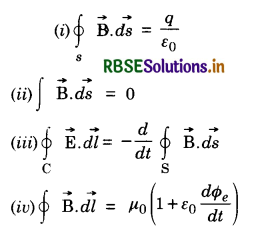
Question 6.
State the characteristics of e.m. waves.
Answer:
Characteristics of e.m. waves are:
- The e.m. waves consist of electric and magnetic fields oscillating perpendicular to the direction of propagation.
- They are transverse in nature.
- The rate of flow of energy per unit area is \(\overrightarrow{\mathrm{E}} \times \overrightarrow{\mathrm{B}}\) and is along the direction of propagation.
- The oscillations of \(\overrightarrow{\mathrm{E}}\) and \(\overrightarrow{\mathrm{B}}\) are in plane with each other.
- The wave velocity is given by c = \(\frac{1}{\sqrt{\mu \varepsilon}}\) and the flow of energy takes place also with the same speed.
- Electric energy density = \(\frac{1}{2}\) εE2
= Magnetic energy density
= \(\frac{1}{2}\) µB2
Question 7.
A closed loop of B is produced by a changing electric field. Does it necessarily mean that E and dE/dt are non-zero at all points on the loop and in the area enclosed by the loop?
Answer:
Not necessarily. All that is needed is that the total electric flux through the area enclosed by the loop should vary in time. The flux change may arise from any portion of the area. Elsewhere E or dE/dt may be zero. In particular, there need be no electric field at the points which make the loop.
Question 8.
If you find closed loops of B in a region in space, does it necessarily mean that actual charges are flowing across the area bounded by the loops?
Answer:
Not necessarily. A displacement current (such as that between the plates of a capacitor that is being charged) can also produce loops of \(\overrightarrow{\mathrm{B}}\).
Question 9.
Why is it that induced electric fields due to changing magnetic flux are more readily observable than the induced magnetic field due to changing electric fields?
Answer:
The magnetic field is due to displacement current. The magnitude is too small to be easily observable. Of course, we can increase the effect by increasing the displacement current (in an a.c. circuit this can be done by increasing ω). The effect of induced electric field due to changing mangnetic flux, on the other hand, can be increased simply by taking more and more number of turns in the coil. The induced e.m.fs. produced in different turns of the same coil add up in series.
Question 10.
State the principle of production of e.m, waves. What is the value of velocity of these waves?
Or
How are electromagnetic waves produced? Explain.
Answer:
An electric charge at rest has only electric field around it and no magnetic field. A moving charge (with uniform velocity) has both electric and magnetic field around it. But as the current is not changing with time, so magnetic field will also be uniform and hence no electromagnetic wave is produced. If the charge is moving with accelerated motion, both electric and magnetic field will be changed and hence e.m. wave is produced. Thus, the accelerated charge produces electric and magnetic fields which vary both in space and time. These varying electric and magnetic fields give rise to electromagnetic waves.
Velocity of e.m. waves is 3 x 108 ms-1
Question 11.
What is electromagnetic spectrum? To what uses it is put to?
Answer:
Orderly distribution of electromagnetic radiations according to their frequency or wavelength is called electromagnetic spectrum. The e.m. spectrum has much wider range of wavelength, variation from 10-14 m to 6 x 106m and the frequency ranging from 1024 Hz. to 50 Hz. Some overlapping is also observed in some parts of the spectrum showing that the corresponding radiation can be produced by two methods.
Gamma rays have minimum wavelength and is ranging from 10-14 m to 10-20 m. X-rays have wavelength greater than gamma rays followed by ultraviolet rays and visible light. In visible, violet colour has a wavelength of about 3500 Å and red has wavelength of about 7000 Å. Infrared rays come next followed by microwaves, ultra high frequencies, very high frequencies, radio frequencies and power frequencies.
Human eye is sensitive to only a very small part of electromagnetic spectra and is maximum sensitive at 5500 Å.
Uses of e.m. spectra
- Study of gamma rays provides useful information about the structure of atomic nuclei.
- Study of atomic and crystal structure can be done by X-rays.
- X-rays are used in medical diagnosis and as a medicine to kill certain bacteria which cannot be killed by any medicine.
- Infrared, visible and ultraviolet radiation help us to know the structure of the molecules and arrangement of electrons in external shell.
- U.V. radiations are used in the detection of invisible writing, forged documents and in preservation of finger prints.
- Radio and microwaves are used in radio and T.V. communication system.
- Infrared rays are used in warfare in looking through fog, mist, clouds etc. It is also used in revealing secret writing on ancient walls and in greenhouses.

Question 12.
Radio waves diffract pronouncedly around building, while light waves do not. Why?
Answer:
For the diffractions to take place, the size of the obstacle should be of the order of wavelength of incident waves. Radio waves have wavelength of a few metres and hence comparable to the size of the walls. In case of light waves, the wavelength is of the order of 10-7 m and not comparable to size of wall.
Hence radio waves diffract more pronouncedly.
Question 13.
Discuss briefly the behaviour of earth’s atmosphere towards the propagation of electromagnetic waves.
Answer:
The region between 80 km to 400 km above the surface of the earth, called ionosphere, plays a very vital role in the propagation of electromagnetic waves. Ionosphere is mostly composed of free electrons and ions which are produced due to ionisation caused by ultraviolet radiations and X-rays coming from the sun. Electron density is found to vary very largely beyond 110 km and extend vertically beyond 110 km. This layer of electrons is called Kennelly heavy side layer. Beyond this, electron density decreases considerably upto a height of 250 km. A layer of electron is again there and is called Appleton layer.
Both these layers play significant role in the conduction of electromagnetic waves.
Question 14.
Differentiate between ground waves and sky waves propagation.
Answer:
Ground waves propagation. The amplitude-modulated radio waves which are travelling directly following the surface of the earth are known as ground waves or surface waves. These can have frequency upto 1,500 kHz. Ground waves can bend around corners of the objects on the earth and their intensity falls with distance. Their transmission becomes weaker as the frequency increases. These waves cannot travel long distances.
Sky waves propagation. The amplitude-modulated radio waves which are received after being reflected from the ionosphere are called sky waves. This type of wave can be used between 1,500 kHz upto 40 MHz.
Question 15.
Explain greenhouse effect.
Answer:
Radiations from the sun fall on the surface of earth. Earth reflects back infrared or heat radiations. When they fall on low lying clouds, they are reflected back. Thus they keep the earth warm at night. This is called greenhouse effect.
Had there been no greenhouse effect, the earth would have cooled down to very low temperature during night. It would, have been very troublesome for us.
Question 16.
Explain why moon has no atmosphere.
Answer:
The existence of atmosphere on planet or moon can be decided by the following two factors:
- Acceleration due to gravity.
- Surface temperature.
Moon has very low value of g (l/6th of that of earth). We know escape velocity = \(\sqrt{2 g \mathrm{R}}\). both g and R, the radius of the moon is very small, hence escape velocity is very small i.e. roughly it is 2.4 km s-1.
The temperature of the moon during day is high i.e. 110°C and hence its rms velocity is quite large. Most of the molecules have velocities greater than escape velocities and hence all the gases have escaped moon's atmosphere.
Hence moon has no atmosphere.

Question 17.
Explain surface wave and sky wave propagation of radio waves. Why is short wave communication over long range not possible by surface wave propagation?
Answer:
Surface wave or ground wave propagation. Amplitude-modulated radio waves travelling directly from one place to another over the surface of the earth is called surface or ground waves.
Sky wave propagation. The amplitude-modulated radio waves which are received back after being reflected from the ionosphere are called sky waves.
Why short wave communication over long distances are not possible by surface wave propagation?
For radio communication of short wavelength (λ less than 200 m or frequency greater than 1500 kHz), sky waves are only used. The ground waves on lending round the corner of the earth loses good amount of energy due to absorption and their intensity falls to a very small value. Hence short waves are undetectable in surface wave propagation.
Question 18.
Why are microwaves used in Radar?
Answer:
Microwaves are waves of very short wavelength and hence frequency higher than T.V. signal. Due to their short wavelength, these waves are not diffracted by the obstacle of normal dimensions and hence used in radars for locating an aeroplane or any other obstacle.
Question 19.
Write the order of frequency range and one use of each of the following electromagnetic radiations.
(i) Microwaves
(ii) Ultraviolet rays
(iii) Gamma rays.
Answer:
(i) Range of microwaves is from 1 x 109 Hz to 3 x 1011 Hz and are used for cooking in microwave oven.
(ii) Range of ultraviolet rays is from 8 x 1014 Hz to 3 x 1017 Hz and are used to destroy bacteria and sterilizing surgical instruments.
(iii) Range of Gamma rays is from 3 x 1018 Hz to 5 x 1022 Hz and are used for treatment of cancer and tumours.
Question 20.
A plane e.m.wave of frequency 25 MHz travels in space along the x-axis. At a particular point in space and time the electric vector
\(\overrightarrow{\mathbf{E}}\) = 6.3 Vm-1 \(\hat{\mathbf{j}}\). Calculate \(\overrightarrow{\mathbf{B}}\) at this point.
Answer:
v = 25 MHz
\(\overrightarrow{\mathbf{E}}\) = 6.3 Vm-1 \(\hat{\mathbf{j}}\)
∴ E = 6.3 Vm-1
∴ B = \(\frac{E}{c}=\frac{6.3}{3 \times 10^8}\)
= 2.1 x 10-8 T
So \(\overrightarrow{\mathbf{B}}\) = 2.1 x 10-8 T \(\hat{\mathbf{k}}\)
Question 21.
Do all current carrying conductors emit electromagnetic waves? Explain.
Answer:
No. If d.c. current is passed through a conductor, there will be no variation of electric flux Φ and hence the displacement current.
Id = ε0\(\frac{d \phi}{d t}\) = 0
If. a.c. current is passed, then \(\frac{d \phi}{d t}\) is finite and there is displacement current and hence electromagnetic waves can be produced.

Question 22.
Microwaves are better carriers of signals than radio waves. Explain.
Answer:
Microwaves are better carriers of signals than radio waves (Radar). Radio waves with wavelength less than that of television signals are the microwaves they have wavelengths of the order of a few millimetres. We know from day-to-day experience that a beam of light keeps along a straight path unlike a sound wave which spreads and also bends around the corners of any obstacles in its way. This phenomenon, is due to the difference in the wavelenghts of sound and light waves in comparison to the size of the obstacles. Because of their relatively smaller wavelengths compared to radio waves, microwaves are much better suited if one wants to ‘beam’ signals in a particular direction. Because they do not bend or spread around the corner of any obstacle coming in their path.
Question 23.
The oscillating magnetic field in a plane electromagnetic wave is given by:
B = 8 x 10-6 sin (2 x 1011 t + 300 πx) T
(i) Calculate the wavelength of the electro-magnetic wave.
(ii) Write down the expression for the oscillating electric field.
Answer:
(i) Comparing the given equation with standard equation
By = B0 sin (ωt + kx), we get
k = 300 π
or \(\frac{2 \pi}{\lambda}\) = 300 π
or λ = \(\frac{2 \pi}{300 \pi}\)m = 0.006 m
(ii) Since E0 = cB0
= 3 x 108 x 8 x 10-6
= 2400 Vm-1.
The electric field component is perpendicular to the direction of propagation and the direction of magnetic field. So the electric field component is along Z-axis and is given by
Ez 200 sin (2 x 1011 t + 300 πx) Vm-1.
Question 24.
The oscillating electric field of an electromagnetic wave is given by Ey = 30 sin (2 x 1011 t + 300 πx) Vm-1.
(a) Obtain the value of the wavelength of the electromagnetic wave.
(b) Write down the expression for the oscillation magnetic field.
Answer:
(a) Comparing the given equation, with standard equation
Ey = E0 sin (ωt + kx)
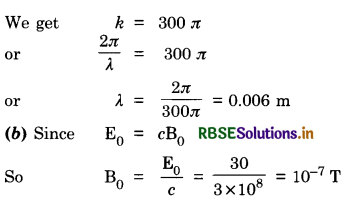
The magnetic field component is perpendicular to the direction of propagation and the direction of electric field. Therefore, the magnetic field component is along z-axis and is given by
Bz = 10-7 sin (2 x 1011 t +300 πx) T.
Question 25.
What is meant by the transverse nature of electromagnetic waves? Draw a diagram showing the propagation of an electromagnetic wave along the X-direction, indicating clearly the directions of the oscillating electric and magnetic fields associated with it.
Answer:
Transverse nature of electromagnetic wave means that the electric and magnetic field vectors of the wave vibrate perpendicular to the direction of propagation of the electromagnetic wave.
The diagram is shown below.
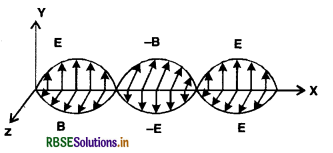
Question 26.
An electromagnetic wave is travelling in a medium with a velocity \(\vec{v}=v \hat{i}\) . The electric field oscillations, of this electromagnetic wave, all along the Y-axis.
(а) Identify the direction in which the magnetic field oscillations are taking place of the e.m. wave.
(b) How are the magnitude of the electric and magnetic fields in the electromagnetic wave related to each other?
Answer:
Since \(\vec{v}=v \hat{i} \), it means that the e.m. wave is moving along X-axis.
(а) The direction of magnetic field oscillation is along Z-axis.
(b) The relation between E and B is
\(\frac{\mathrm{E}}{\mathrm{B}}\) = v.

Question 27.
Identify the electromagnetic waves whose wavelength vary as
(a) 10-12 m < 1 < 10-8 m
(b) 10-3 m < 1 < 10-1 m
Write one use of it.
Answer:
(a) X-ray
X-rays are used in surgery and in radio therapy.
(b) Gamma rays
Gamma rays are used for the treatment of cancer.
Question 28.
How is electromagnetic wave produced? Draw a sketch of a plane electromagnetic wave propagating along x-axis depicting the directions of the oscillating electric and magnetic fields.
Answer:
Electromagnetic waves are produced by oscillating electric and magnetic fields.
Sketch of e.m wave
Transverse nature of electromagnetic wave means that the electric and magnetic field vectors of the wave vibrate perpendicular to the direction of propagation of the electromagnetic wave.
The diagram is shown below.
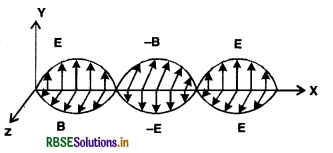
Question 29.
(i) Identify the part of electromagnetic spectrum used in (a) radar and (b) eye surgery. Write their frequency range.
(ii) Prove that average current density of the oscillating electric field is equal to that of oscillating magnetic field.
Answer:
(i) Microwaves : Frequency range (1010 to 1012 Hz)
Ultraviolet rays : Frequency range (1015 to 1017 Hz)
(ii) Average density of the electric field is
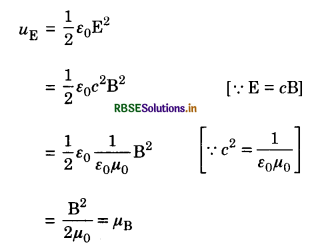
Question 30.
Draw a labelled diagram of Hertz’s experiment set up to produce electromagnetic waves. Explain the generation of elctromagnetic waves using this set up.
Answer:
The existence of electromagnetic wave was confirmed experimentally by Hertz in 1888. This experiment is based on the fact that an oscillating electric charge radiates electromagnetic waves. The energy of these waves is due to kinetic energy of the oscillating charge. The experiment arrangement is as shown in the figure. It consists of two metal plates A and B placed at a distance of 60 cm from each other. The metal plates are connected to two polished metal spheres S1 and S2 by means of metal rods. Using an induction coil a high potential difference is applied across the small gap between the spheres. Due to high potential difference across S1 and S2, the air in small gap between the spheres get ionized and provides a path for the discharge of the plates. A spark is produced between S1 and S2 and electromagnetic waves of high frequency radiated.
Hertz was able to produce electromagnetic waves of frequency about 5×107 Hz. Here the plates A and B acts an a capacitor having small capacitance value C and connecting wire provide low inductance L. Thus the plates and the rods (with spheres) constitutes and LC combination. The high frequency oscillation of charges between the plates is given by
V = \(\frac{1}{2 \pi \sqrt{\mathrm{LC}}} \)
Wavelength of the electromagnetic produced is given by
λ = \(\frac{\mathrm{c}}{\mathrm{v}}=\frac{3 \times 10^8}{5 \times 10^7}\) = 6 cm
An open metallic ring of diameter 0.70 m having small metallic spheres acts as a detector. This constitutes another LC combination whose frequency can be varied by varying its diameter.
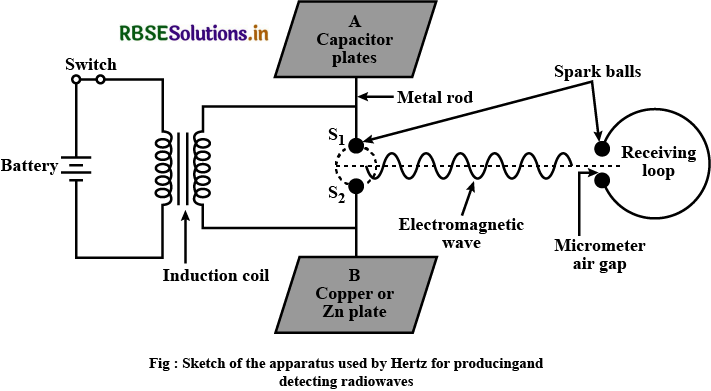
Question 31.
Name the constituent radiation of electromagnetic spectrum which
(а) is used in satellite communication.
(b) is used for studying crystal structure.
(c) is similar to the radiations emitted during the decay of radioactive nuclei.
(d) has its wavelength range between 390 nm and 700 nm.
(e) is absorbed from sunlight by ozone layer.
(f) produces intense heating effect.
Answer:
(a) In satellite communication, short radio waves having frequency v > 30 mHz are used.
(b) For studying crystal structure, X-rays are used.
(c) Gamma radiation is similar to the radiation emitted during the decay of radioactive nuclei.
(d) Visible light has range between 300 nm to 700 nm.
(e) Ultraviolet rays are absorbed from sun light by ozone layer.
(f) Infrared radiation produces intense heating effect.

Question 32.
When can a charge act as a source of electromagnetic wave? How are the directions of electric and magnetic Held vectors, in an electromagnetic wave related to each other and to the direction of propagation of the wave?
Which physical quantity, if any has the same value for waves belonging to the different parts of the electromagnetic spectrum?
Answer:
An accelerated (or deaccelerated) charge or oscillating LC circuit is a source of electromagnetic waves. In an electromagnetic wave, the electric and magnetic field vectors are perpendicular to each other and also perpendicular to the direction of propagation of wave e.g. if the e.m. wave is moving towards X-axis, the electric field vector is along Y-axis and magnetic field vector is along Z-axis. And the propagation vector \(\vec{k}\), electric field vector \(\vec{E}\) and magnetic field vector \(\vec{B}\), form a right handed orthogonal system.
The speed of all electromagnetic waves belonging to the different parts of the electromagnetic spectrum is the same in vacuum and is equal to velocity of light c = 3 x 108 ms-1.
Question 33.
Which constituent radiation of the electromagnetic spectrum is used:
(i) in radar
(ii) to photograph internal parts of a human body and
(iii) for taking photographs of the sky during night and foggy conditions? Give one reason for you answer.
Answer:
(i) Microwaves are used in radar. Because microwaves are of short wavelength and they go straight during transmission without bending.
(ii) X-rays are used to photograph internal parts of a human body.
Because X-rays can penetrate light elements like flesh of human body.
(iii) Infrared radiations are used for taking photographs of the sky during night and foggy conditions.
Because infrared rays can penetrate fog and are not absorbed by the atmosphere.
Question 34.
Write the order of frequency range and one use of each of the following electromagnetic radiations
(i) microwaves
(ii) ultraviolet rays
(iii) gamma rays.
Answer:
The frequency range of microwaves is 3 x 108 to 3 x 1011 Hz.
They are used in microwave ovens for cooking.
(ii) The frequency range of ultraviolet rays is 3 x 1014 to 8 x 1016 Hz. They are used for purification of water.
(iii) The frequency range of gamma rays is 3 x 1019 to 5 x 1020 Hz.
They are used in the treatment of cancer and tumours.
Question 35.
A plane e.m. wave of frequency 25 MHz travels in space along the X-axis. At a particular point in space and time the electric vector
\(\overrightarrow{\mathbf{E}}\) = 6.3 Vm-1 \(\hat{\mathbf{j}}\). Calculate \(\overrightarrow{\mathbf{B}}\) at this point.
Answer:
v = 25 MHz
\(\overrightarrow{\mathbf{E}}\) = 6.3 Vm-1 \(\hat{\mathbf{j}}\)
∴ E = 6.3 Vm-1
∴ B = \(\frac{\mathrm{E}}{c}=\frac{6.3}{3 \times 10^8}\) = 2.1 x 10-8 T
So \(\overrightarrow{\mathbf{B}}\) = 2.1 x 10-8 T \(\hat{\mathbf{k}}\)
Question 36.
The magnetic field in a plane electromagnetic wave is given by
By = 12 x 10-8 sin (1.20 x 107 z + 3.60 x 1015 t) T:
Calculate the
(i) Energy density associated with the electromagnetic wave
(ii) Speed of wave.
Answer:
(i) Energy density u = \(\frac{\mathbf{B}^2}{\mu_0}\) = 11.5 x 10-9 Jm-3
Speed of the wave v = \(\frac{\omega}{k}\) = C = 3x 108 ms-1.

Question 37.
Do electromagnetic waves carry energy and momentum?
Answer:
Yes.
Energy E = \(\frac{h c}{\lambda}\)
And momentum p = mc
where, c is speed of light and λ is wavelength of wave.
Long Answer Type Questions
Question 1.
State and explain Maxwell’s modification of Ampere’s circuital law.
Or
Show that modification is needed for Ampere’s law.
Or
Show that Ampere’s circuital law is logically inconsistent.
Answer:
Ampere's circuital law. According to Ampere’s circuital law, the closed line integral of magnetic field is equal to µ0 times the current passing through the loop.
i.e.\(\oint \overrightarrow{\mathrm{B}} \cdot \overrightarrow{d l}\) = µ0 I ......................(i)
where I is the current round the bounded closed path.
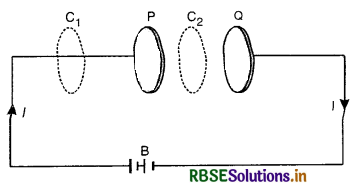
Maxwell showed that the above relation is consistent. To support his submission, he considered a capacitor having plates P and Q charged by battery B. During charging the current flows through connecting wires and this current changes with time. A magnetic field is produced around connecting wires due to the current. Consider two loops C1 and C2 parallel to plates P and Q of the capacitor. C1 is enclosing only connecting wires attached to the plate P and C2 in the region between two plates of the capacitor.
Applying Ampere’s circuital law of the given circuit.
For loop C1
\(\oint_{C_1} \overrightarrow{\mathrm{B}} \cdot \overrightarrow{d l}\) = µ I ...........................(ii)
For loop C2
Since no current passes between the region
i.e. I = 0,
\(\oint_{C_2} \overrightarrow{\mathrm{B}} \cdot \overrightarrow{d l}\) = µ0(0) = 0 .............................(iii)
Above relations are true even if C1 and C2 are infinitesimally close to P. If C1 and C2 are infinitestimally close, then it is expected that:
\(\oint_{C_1} \overrightarrow{\mathrm{B}} \cdot \overrightarrow{d l} = \oint_{C_2} \overrightarrow{\mathrm{B}} \cdot \overrightarrow{d l}\) ......................(iv)
Above relation is in contradiction to relations (ii) and (iii).
Thus Maxwell concluded that Ampere's circuital law as given by relation (i) is logically inconsistent.
Maxwell suggested a modification to Ampere’s circuital law to avoid contradiction. The modified Ampere’s circuital law or Ampere-Maxwell law is given by:
\(\oint_{C_1} \overrightarrow{\mathrm{B}} \cdot \overrightarrow{d l}\) = µ0(I + ε0\(\frac{d \phi_e}{d t}\))
= µ0I + µ0ε0 \(\frac{d \phi_e}{d t}\) ...........................(v)
where Φe = electric flux across the loop and
ε0\(\frac{d \phi_e}{d t}\) = ID, the displacement current
∴ Modified Ampere's circuital law is:
\(\oint_{C_1} \overrightarrow{\mathrm{B}} \cdot \overrightarrow{d l}\) = µ0 (I + ID) ..................................(vi)
where I is the conduction current arising due to the conduction of electron and ID is the displacement current which exists so long as the electric field changes with time. This shows that electric current varying with time produces magnetic field.
Question 2.
Ampere-Maxwell law is applicable to all closed paths inside or outside the plates of the capacitor. Explain.
Answer:
Consider a parallel plate capacitor having plates P and Q charged with battery B as shown in Fig. LAQ 8.2. From Ampere-Maxwell’s law, we have
\(\oint \overrightarrow{\mathrm{B}} \cdot \overrightarrow{d l}=\mu_0 \mathrm{I}+\mu_0 \varepsilon_0 \frac{d \phi_e}{d t}\) .........................(1)
Let us apply this law to the given circuit.
For loop C1
As there is no electric flux linked with loop C1, so Φe = 0
∴ \(\oint_{\mathrm{C}_1} \overrightarrow{\mathrm{B}} \cdot \overrightarrow{d l}\) = µ0I + 0 = µ0I ..............................(2)
For loop C2
As there is no conduction current looping the surface C2, so I = 0, but electric flux is linked with the surface.
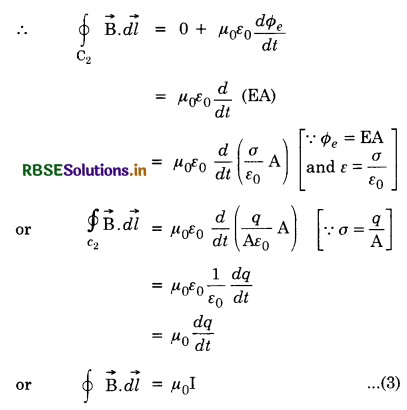
where A is area of each plate of the capacitor and E is the electric field between the plates.
From Eq. (2) and (3), we find that
\(\oint_{\mathrm{C}_1} \overrightarrow{\mathrm{B}} \cdot \overrightarrow{d l} = \oint_{\mathrm{C}_2} \overrightarrow{\mathrm{B}} \cdot \overrightarrow{d l}\)
Thus we find that the modified Ampere’s circuital law is valid for all closed surfaces lying inside or outside the plates of the capacitor.

Question 3.
Discuss the quantitative production of electromagnetic waves when a charge is accelerated.
Or
Electromagnetic charge emits electro-magnetic waves.
Answer:
Consider an electric charge at rest so that at a point P some distance away, we have an electric field but no magnetic field. Let, at time t = 0, an impulse be given to the charge such that it starts moving with some finite velocity. For a moving charge, we expect at P both electric and magnetic fields, but we cannot immediately decide whether the magnetic field at P will change from zero to a finite value instantaneously at t = 0 or after some time.
Instantaneous change means infinite rate of change. If the change is instantaneous at all points then considering any loop, we will conclude from Faraday's law that an infinite e.m.f. and infinite electric field is set up. This in turn would imply an infinite magnetic field as seen from the result. Fields are always finite away from charges and clearly the situation just described is inconsistent with known laws of electricity and magnetism.
\(\oint \overrightarrow{\mathrm{B}} \cdot \overrightarrow{d l}=\mu_0 \varepsilon_0 \frac{d \phi_e}{d t}\)
The moving charge sets up a magnetic field in its neighbourhood which in turn creates an electric field in the neighbourhood. The process continues since both time-varying electric and magnetic fields act as sources of each other. Thus an electromagnetic wave is started when a charge is accelerated. It is only when the wave reaches the point P that the magnetic field at P changes.
This shows that an accelerated charge emits an electromagnetic wave. It can also be shown that the electromagentic wave and the oscillator will have the same frequency.
Question 4.
What are Maxwell’s equations and Lorentz’s force. What are their characteristics and importance?
Answer:
Maxwell’s Equations
Maxwell’s equations are as fundamental to electricity and magnetism as Newton’s laws to study mechanics. In free space (i.e. in the absence of dielectric or magnetic materials), the four Maxwell’s equations are as follows:
1. \(\oint \overrightarrow{\mathrm{E}} \cdot \overrightarrow{d s}=\frac{q}{\varepsilon_0}\)
Characteristics
- It summarises Gauss’s law in electrostatics.
- It gives relation between electric field and charge distribution.
- It shows that electric lines of force start from +ve charge and end at the - ve charge
2. \(\oint \vec{B} \cdot \overrightarrow{d s}\) = 0
Characteristics
- It summarises Gauss’s law in magnetism.
- It shows that isolated magnetic poles do not exist.
- It shows that there is no starting or end point of magnetic lines of force.
3. \(\oint \vec{E} \cdot \overrightarrow{d s}\) = -\(\frac{d \phi_m}{d t}\)
= -\(\frac{d}{d t} \oint \overrightarrow{\mathrm{B}} \cdot \overrightarrow{d s}\)
Characteristics
- It summarises Faraday's laws of electromagnetic induction.
- It shows that line integral of electric field around any closed path is the rate of change of magnetic flux linked with the closed path.
- Time variation of magnetic field produces electric field.
4. \(\oint \overrightarrow{\mathrm{B}} \cdot \overrightarrow{d s}=\mu_0 \mathrm{I}+\mu_0 \varepsilon_0 \frac{d \phi_e}{d t}\)
= µ0I + µ0ID
Characteristics
- It summarises the modified form of Ampere’s circuital law.
- The line integral of magnetic field around any closed path is related to conduction current I and displacement current ID.
- Magnetic field can be produced by conduction current as well as displacement current.
5. Lorentz’s force
The Lorentz’s force \(\overrightarrow{\mathrm{F}}\) on a moving charge q having velocity \(\overrightarrow{\mathrm{v}}\) in electric and magnetic field is given by
\(\overrightarrow{\mathrm{F}}=q \overrightarrow{\mathrm{E}}+q\left(\overrightarrow{l^{\prime}} \times \overrightarrow{\mathrm{B}}\right)\)
These four Maxwell’s equations and Lorentz’s force give the complete description of all electromagnetic interactions.
Importance
From Maxwell’s equations, Maxwell predicted theoretically that
- time variation of magnetic field produces electric field.
- an accelerated electron charge can produce electromagnetic waves.
- electromagnetic waves are transverse in nature.
- velocity of electromagnetic waves in free space is 3 x 108 ms-1.

Question 5.
State and explain electromagnetic waves.
Answer:
Electromagnetic waves
Electromagnetic waves are those waves in which there are sinusoidal variations of electric and magnetic fields at right angle to each other as well as at right angle to the direction of propagation of the waves.
e.g. visible light, U.V. rays, I.R. rays, X-rays, γ-rays microwaves, radio waves etc.
Production of electromagnetic waves
We know that a charge at rest can have only electric field around it. If the velocity of the charge is uniform, the magnetic field produced by it will also be uniform and hence no electromagnetic wave is produced. But if the charge is moving with accelerated motion both electric and magnetic fields will be changed and hence changing magnetic field will be produced, hence electromagnetic wave is produced. It means that only an accelerated charge emits electromagnetic waves, e.g. In an L-C circuit, the growth and decay of charge in the capacitor and growth and decay of magnetic field in the inductor L produce electromagnetic wave. In an atom, when an electron jumps from higher energy level to lower energy level, electromagnetic waves are produced.
Characteristics of e.m. waves
- When electric and magnetic fields vary along the direction perpendicular to each other, the energy propagates normal to their plane called electromagnetic wave.
- No material medium is required for the propagation of electromagnetic waves i.e. they can travel in vacuum.
- In free space (vacuum), velocity of electromagnetic waves is 3 x 108 ms-1.
- Energy of electromagnetic wave is divided equally between electric and magnetic vectors.
- The velocity of electromagnetic waves is independent of amplitude of electric and magnetic vectors and depends only on the electric and magnetic properties of the medium in which e.m. waves travel.
- Velocity of electromagnetic wave decreases in a denser medium.
- The electric vector is responsible for the optical effect of the wave and hence electric vector is called light vector.
- Electric and magnetic fields are in the same phase, their values become zero and maximum at the same instant as shown in this figure.
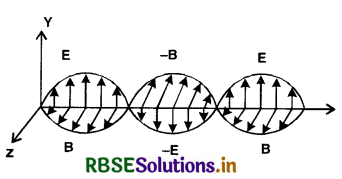
Question 6.
Explain with the help of a diagram, Hertz’s experiment for the production of electromagnetic waves.
Or
Draw the labelled diagram of Hertz’s experiment set-up to produce electromagnetic waves. Explain the generation of electomagnetic waves using this set up.
Answer:
After the theoretical prediction of electromagnetic waves in 1865, Hertz experimentally confirmed their existence in 1888.
Principle. An oscillating electric charge radiates out electromagnetic radiations. The radiation carried energy and this energy is being supplied at the cost of kinetic energy of the oscillating charge. However, it is known that the radiation is appreciable only if the extent to which the charge oscillates is comparable with the wavelength of radiation. An electron oscillating with a frequency of 103 cs-1 gives e.m. waves of wavelength.
λ = \(\frac{c}{v}=\frac{3 \times 10^8}{10^3}\)m
= 300 km
Thus, the charge must oscillate over a distance of 300 km in order to radiate sufficient amount of energy. Hertz designed a system of the oscillating charges of much higher frequency so that the system may be used in a laboratory.
Hertz’s apparatus. The two metal sheets are connected to a source of high voltage (induction coil). The voltage is high enough such that the air in the small gap between the plates gets ionized and provides a path for discharge of the plates. The plate arrangement clearly gives a very low value of L and C, so that according to ω = \(\frac{1}{\sqrt{\mathrm{LC}}}\), very high frequency oscillations of charges on the plates will result. Hertz produced electromagnetic waves of wavelength around 6 m.
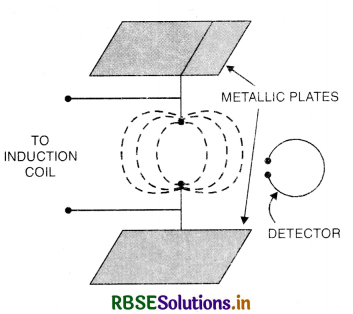
The detector is held in a position such that the magnetic field produced by the oscillating current is perpendicular to the plane of the coil. The resultant electric field, induced by the oscillating magnetic field causes sparks to appear at the narrow gap.

Question 7.
Show that electromagnetic wave is transverse in nature.
Answer:
Consider an electromagnetic plane wave travelling in the X-direction and an elementary parallelopiped OABCDEFG placed with its edges parallel to the three axes, Fig. The wavefront is the YZ plane and ABCD is a portion of it at time t. The electric and magnetic fields will be zero to the right of the face ABCD. but to the left of this face the values of the two fields depend on x and t but not on y and z, since we are considering plane wave.
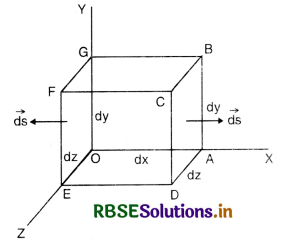
Consider the rectangular parallelopiped not enclosing any charge. The total electric flux across it must be zero, according to Gauss’s law i.e.
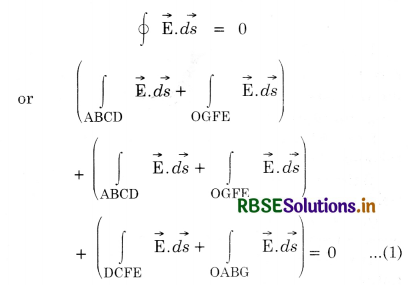
Since \(\overrightarrow{\mathrm{E}}\) does not depend on y and z, therefore the contribution to the total electric flux coming from the faces normal to y and z axes will cancel out in pairs i.e.
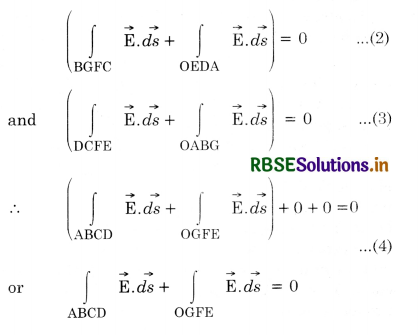
If Ex and Ex' are the values of X-component of electric field on face ABCD and OGFE respectively, then we have
\(\int_{\mathrm{ABCD}} \mathrm{E}_x d s \cos 0^{\circ}+\int_{\text {OGFE }} \mathrm{E}_{x^{\prime}} d s \cos 180^{\circ}=0\)
or ∫Ex ds - ∫Ex' ds = 0
or Ex dydz - Ex' dydz = 0
or (Ex - Ex') dydz = 0
As dy dz ≠ 0
∴ Ex - Ex' = 0
This relation is true only if
either Ex - Ex' = 0
or Ex = Ex'
If Ex = Ex' it would mean that the electric field associated with the electromagnetic wave is static and as such static electric field cannot generate electromagnetic waves, so Ex ≠ Ex'.
∴ Ex = Ex' = 0
It means that no electric field exists along the direction of propagation of the e.m. wave. Similarly we can prove that no magnetic field exists along the direction of propagation of the e.m. wave.
Thus we conclude that in the propagation of electromagnetic waves, the electric and magnetic fields are transverse i.e. perpendicular to the direction of wave propagation. Hence electromagnetic waves are transverse in nature.

Question 8.
Show that the ratio of electric and magnetic field is equal to velocity of light (i.e. e.m. wave)
Or
Derive the expression for the velocity or speed of electromagnetic wave.
Answer:
Consider that an electromagnetic wave be travelling along +ve X-direction. The electric field is along Y-axis and magnetic field along Z-axis as shown in [Fig. LAQ 8]
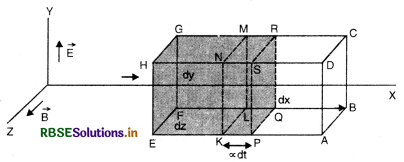
Let at any time t. the wave be in plane KLMN and at time t + dt, it advances to plane PQRS.
If c is the velocity of e.m. wave, then the distance covered by the wavefront in time dt is given by KP = LQ = MR = NS = c dt
As the wavefront propagates, there is change in magnetic flux through the face BCGF and electric flux changes through face ABFE
(i) Change in magnetic flux through face BCGF
Increase in magnetic flux
dΦB = B x Increase in area
= B [LM x LQ]
= B dy c dt
or\( \frac{d \phi_{\mathrm{B}}}{d t}\) = B c dy
From Farady's law pf electromagnetic induction, we have
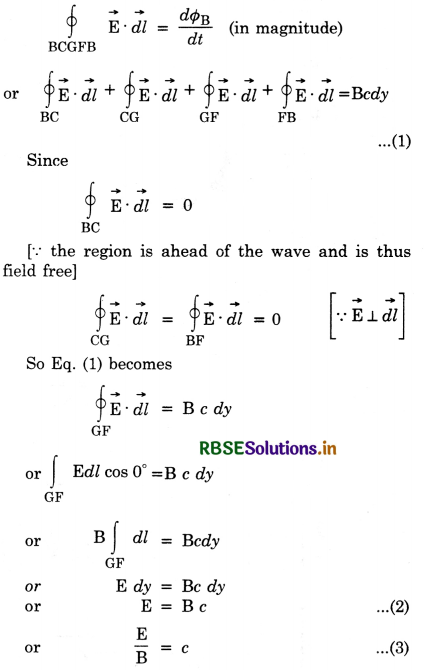
i.e. ratio of electric and magnetic field is equal to velocity of light.
(ii) Change in electric flux through face ABFE
Increase in electric flux
dΦe = E(Increase in area)
or dΦe = E [PQ x LQ]
= E dz c dt
or \(\frac{d \phi_e}{d t}\) = c E dz ...............................(4)
Ampere's law in the absence of conduction current is given by
\(\oint_{\mathrm{ABFEA}} \overrightarrow{\mathrm{E}} \cdot \overrightarrow{d l}=\mu_0 \varepsilon_0 \frac{d \phi_e}{d t}\) [∵ I = 0]
By using the same technique as used in solving,
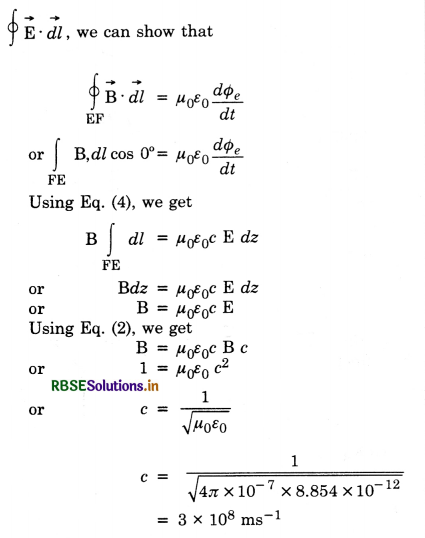
This is speed of light in free space. Thus we find that light is e.m.wave.
In a material medium, the velocity of e.m.wave is given by
c = \(\frac{1}{\sqrt{\mu \varepsilon}}\)
where µ and ε be permeability and permittivity of the medium.

Question 9.
What is electromagnetic spectrum? How are different radiations constituting the electro¬magnetic spectrum produced?
Answer:
Electromagnetic spectrum
Maxwell, on the basis of mathematical equations predicted the existence of electromagnetic waves. He suggested that an accelerated charge can produce a time varying magetic field and time varying magnetic field can produce time varying electric field. After these predictions, in 1887, Hertz experimentally produced and studied these waves. Seven years after Hertz’s experiment, Jagdish Chander Bose (an Indian scientist) produced electromagnetic waves in the range of 5 nm to 25 nm. The arrangement of all electromagnetic waves of different frequencies and wavelengths in increasing / decreasing order is called electromagnetic spectrum.
The orderly distribution of electromagnetic radiations according to their wavelength or frequency is called electromagnetic spectrum.
The electromagnetic spectrum has very wide range with frequency variation 1022Hz to 104 Hz (or wavelength variation 10-14 m to 106 m). The whole electromagnetic spectrum has been classified into different parts and sub-parts in order of increasing wavelength. A very small part of spectrum is visible called visible spectrum. The various parts of electromagnetic spectrum is as shown in fig. LAQ 9.
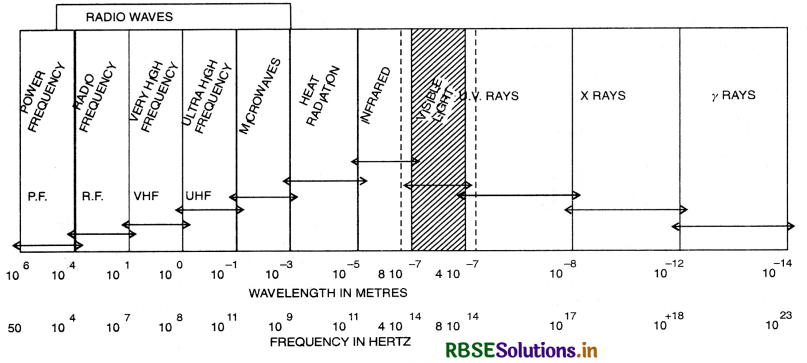
The various regions do not have sharp defined boundaries and thus electromagnetic spectrum is continuous and there is no gap. Velocity of all electromagnetic waves is equal to velocity of light in free space i.e. 3 x 108 ms-1 and c= vλ.
Source of Production
- Gamma rays. Gamma rays are produced when an electron in an atom jumps from higher orbit to lower orbit. The wavelength of y-rays is < 6 x 10-12.
- X-Rays. X-rays are produced when fast moving electrons are made to bombard on a target of high atomic number . The wavelength of X-Rays varies from 6 x 10-12 to 8 x 10-8 m.
- Ultraviolet rays. U.V. rays are produced by excitation of atom, spark and arc lamp. The wavelength of U.V. rays varies from 8 x 10-7 to 3.8 x 10-7.
- Visible light. Visible light is produced by excitation of atoms and molecules. The wavelength of visible light varies from 3.8 x 10-7 - 7.6 x 10-7.
- Infrared rays. I.R. rays are produced by excitation of atoms and molecules. The wavelength of I.R. rays varies from 7.6 x 10-7 m to 0.001 m
- Heat radiations. Heat radiations are produced by hot bodies, and wavelength of heat radiation varies from 10-5 m to 10-3 m.
- Microwaves. Microwaves are produced by oscillating currents in special vacuum tubes. The wavelength of microwaves varies from 0.001 - 0.3.
- Radiowaves. The wavelength of radio waves is > 0.3 m.
- Ultra High Frequency. U.H.F. radio waves are produced by oscillating LC circuits.
- Very High Frequency. VHF radio waves are also produced by oscillating LC circuits.
- Radio frequency. R.F. waves are produced by oscillation LC circuits.
- Power Frequencies. P.F. waves are produced from weak radiations from a.c. circuit.

Question 10.
What are the uses of electromagnetic waves?
Answer:
Uses of electromagnetic waves
Following are some important uses of electromagnetic waves:
- Radio waves. Radio waves are electromagnetic waves and are used in radio and television communication systems.
- Microwaves. Microwaves are used in radar and other communication systems.
- Infrared radiations. Infrared rays are used in:
- solar water heater and solar cooker.
- weather forecasting
- taking photographs during fog, smoke etc.
- dehydrating fruits.
- the treatment of muscular strain.
- greenhouse to keep the plants warm.
- Ultraviolet rays. Ultraviolet rays are used:
- for checking mineral samples by making use of its property of causig fluorescence and also used for the study of molecular structure.
- for sterilizing the surgical instruments because U.V.-rays destroy bacteria.
- in food preservations.
- in detection of invisible writing.
- X- rays. X-rays are used:
- in surgery
- in radiotherapy.
- in medical diagnosis to detect the fracture in bones etc.
- in detective departments to detect gold, diamond etc concealed in bags etc without opening them.
- in scientific research to study the crystal structure etc.
- γ-rays. Gamma rays are used to get information of structure of atomic nucleus.
HOTS QUESTIONS
Question 1.
Find the value of magnetic field between plates of capacitor at distance lm from centre where electric field varies by 1010 Vm-1s-1.
Answer:
Magnetic field between the plates of a capacitor at a distance r having varying electric field is given by
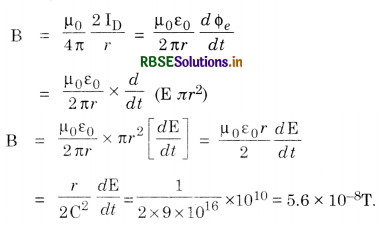
Question 2.
A plane e.m. wave of frequency 40 mHz travel in free space in the x-direction. At some point, at some instant, the electric field\( \overrightarrow{\mathbf{E}}\) has its maximum value at 750 NC-1 in y-direction.
(a) What is the period of the wave?
(b) What is the value of magnitude and direction of magnetic field in 2-direction?
(c) What is the angular frequency of the em wave?
Answer:
Given v = 40 x 106 Hz
∴ T = \(\frac{1}{v}=\frac{1}{40 \times 10^{-6}}\) = 0.25 x 10-6/s
Magnetic field
B0 = \(\frac{\mathrm{E}_0}{c}=\frac{750}{3 \times 10^{18}}\) = 2.5 x 10-6 T along (z direction)
And angular frequency
ω = 2πv = 2 x π x 40 x 106 = 8π x 107 Hz

Question 3.
The oscillating magnetic field in a plane electromagnetic wave is given by
By = 8 x 106 sin (2 x 1011 t + 300 πx) T
(i) Calculate the wavelength of electro-magnetic wave.
(ii) Write down the expression for the oscillating electric field.
Answer:
Given B = 8 x 106 sin (2 x 1011 t + 300 πx) T
(i) On comparing the equation using sinusoidal wave form equation of magnetic field
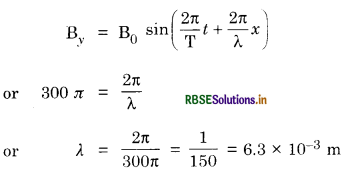
(ii) Electric field is given as
Ez = Bz c = 24 x 1014 sin [2 x 1011 t + 300 πx] Vm-1
Question 4.
Calculate the electric field and magnetic field produced by the rediation coming from a 100 W bulb at a distance of 3 m. Assume that the efficiency of the bulb is 2.5% and it is a point source.
Answer:
When r = 3 m
A = 4πr2 = 4 x 3.14 x 9 = 113 m2
So I = \(\frac{P}{A}=\frac{100 \times 2.5 \%}{113}\) Wm-2 = 0.022 Wm-2
Since half of this intensity is due to magnetic field and half due to electric field. So
\(\frac{\mathrm{I}}{2}=\frac{\varepsilon_0 c \mathrm{E}_v^2}{2}\)
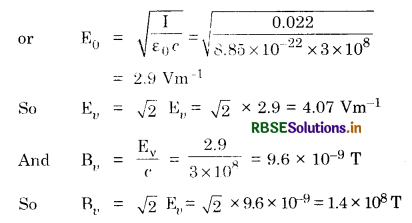

Question 5.
Show that the energy density of em radiation is ε0E2. Hence, find the intensity of radiations?
Answer:
Since uE = \(\frac{1}{2}\)ε0E2
and uB = \(\frac{\mathrm{B}^2}{2 \mu_0}\)
∴ Total energy density u = uE + uB = \(\frac{1}{2} \varepsilon_0 \mathrm{E}^2+\frac{1}{2} \frac{\mathrm{B}^2}{\mu_0}\)
For a plane em wave, B and E are related as
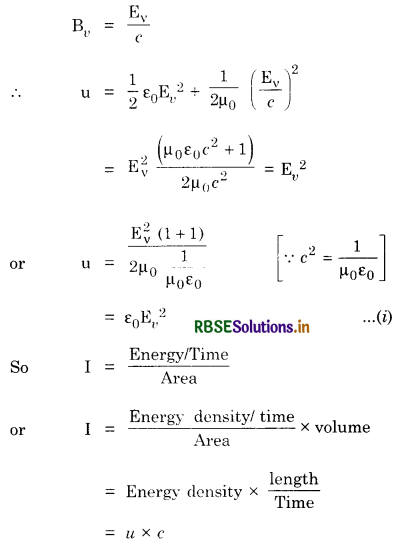
Using eqn. (i), we get
I = ε0c Ev2

- RBSE Class 12 Physics Notes Chapter 2 स्थिर वैद्युत विभव तथा धारिता
- RBSE Class 12 Physics Notes Chapter 3 विद्युत धारा
- RBSE Class 12 Physics Notes Chapter 4 गतिमान आवेश और चुंबकत्व
- RBSE Class 12 Physics Notes Chapter 5 चुंबकत्व एवं द्रव्य
- RBSE Class 12 Physics Notes Chapter 6 वैद्युत चुंबकीय प्रेरण
- RBSE Class 12 Physics Notes Chapter 7 प्रत्यावर्ती धारा
- RBSE Class 12 Physics Notes Chapter 8 वैद्युतचुंबकीय तरंगें
- RBSE Class 12 Physics Notes Chapter 9 किरण प्रकाशिकी एवं प्रकाशिक यंत्र
- RBSE Class 12 Physics Notes Chapter 10 तरंग-प्रकाशिकी
- RBSE Class 12 Physics Notes Chapter 11 विकिरण तथा द्रव्य की द्वैत प्रकृति
- RBSE Class 12 Physics Notes Chapter 12 परमाणु